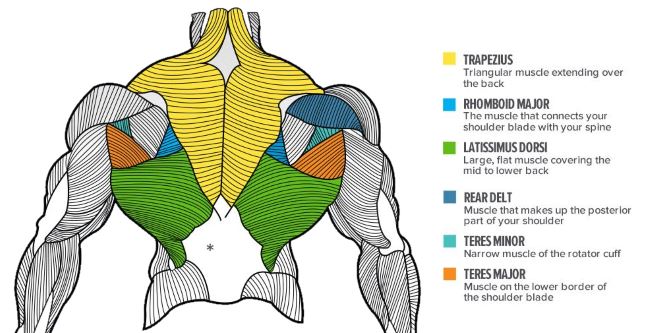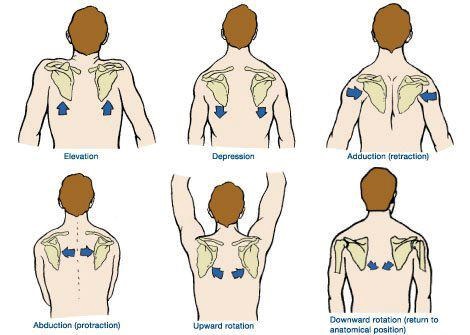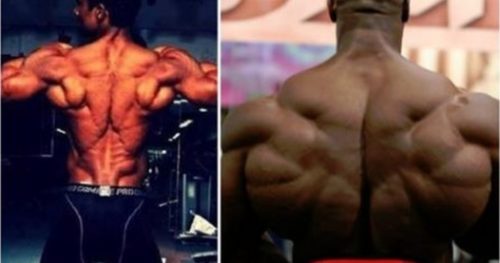Ever since we became a society of technology-addicted hunchbacks, the number of back problems among the population has been on a steady incline. Today, our rotator cuffs and upper back muscles are weaker than ever, and this common issue poses a serious threat in the gym, where many bodybuilders are looking to squat as heavy as possible and use overhead pressing to develop strong upper bodies, disregarding the fact that these two compound exercises require a very tight and stable upper back.
The upper back muscles are responsible for keeping the entire spine braced and stable. When the scapula stabilizers lack strength or stability, there is a high risk of joint misalignment and pain. A lack of scapular stability and mobility is a key factor that can limit athletic performance and result with painful back and shoulder injuries, not to mention its contribution to poor posture. In addition, most athletes emphasize pressing and pushing exercises in their training routines, while pay less attention to antagonistic pulling exercises which are required to counter-balance the effects of the previous movements and enhance shoulder joint stability.
Therefore, sculpting a bigger and stronger upper back is vital for minimizing injuries in the spinal discs and shoulder joints, maintaining good posture and increasing the effectiveness of your performance. There’s no denying that the stronger your shoulder and upper back muscles are, the more weight you can lift in almost any upper body movement. The upper back is made up of the latissimus dorsi, teres major, rhomboids, deltoids, trapezius and infraspinatus. All of these muscles contribute to the ability of the back to withstand heavy loads, and they’re all crucial in building impressive back aesthetics. Additionally, they all have to work as a well-balanced team in order to perform multi-joint exercises, so any weak links will negatively affect the performance of the entire back and diminish your total upper body strength.

So, in case your upper back is nowhere near where it should be, this is the right time to focus on its development in order to break training plateaus and reduce your risk of painful disabling injury. For this goal we’ve created a list of 8 major factors that influence athletic performance to give you a clue on possible areas of improvement, so read carefully.
#1. Scapular retraction

Improving your scapular stability will save your shoulders from the progressive degeneration that is experienced by many more or less ignorant lifters. Scapular stability refers to the ability of your scapula to move freely and offer enough stability to help the shoulder lock in during certain exercises. In this context, scapular retraction, or squeezing your shoulder blades together, is a vital function of your shoulder complex and is incredibly important during lifts such as squats and bench presses. Also, you want to make sure you’re your shoulder blades are properly retracted during most upper body movements because this helps engage the muscle more and increase the tension, providing a better ‘pump’.
However, hyper-retraction can also cause painful issues, so when retracting, you need to make sure to simultaneously retract and suck your shoulder blades into your body by flexing the back and serratus anterior muscles (located on the side of your rip cage). Before choosing a weight to work with, practice this functional movement by simply focusing on achieving optimal contraction of the muscle by placing as much tension as possible on it, then holding the peak contraction for as long as you can. This will give you a better idea of the way your shoulder muscles work and react to different patterns of movement.
#2. Change of grip style
Your gripping style affects the way in which the working muscles will be targeted as well as the choice of accessory muscles, so changing your grip style can lead to more muscle activity and boosted muscle growth. Pronation and supination refer to the positioning of your hands during the exercise – by changing this, you can shift the focus on the muscles and the type of training stimulus applied on them. The supinated grip, which is more isolating and restrictive than its counterpart, will allow you to better target your biceps as secondary muscles, while the pronated grip engages more muscle fibers and creates a better midrange stimulus on the back muscles, primarily targeting the lats and anterior delts.
Changing your grip once in a while will allow you to target different muscles and increase the force applied to them, thereby helping you build a bigger and stronger upper back. In many cases, making some slight tweaks in your grip will change the structure of the entire workout and allow you to engage muscle groups that you’ve never used before.
#3. Angle
Just like the effects of changing grip styles on muscle engagement, changing the angle in which you are pulling from is very important for enabling maximum growth stimuli (needless to say, the grip changes also affect the angle from which the muscle is being worked). For example, the traps, which are the second biggest muscles of the upper back, need to be hit from two main angles in order to fully develop their upper and lower parts. The first one is provided by the shrugging motion, i.e. the shoulder blades moving up, and the second refers to a backward shrugging motion, i.e. the shoulders rolling backward toward the spine.
The good news is that all exercises can be adapted to ensure different muscle fibers are targeted – for example, a low pull row will hit the lower section of the rhombs better, while a high pull row will emphasize the traps and upper rhombs. All you need in order to train the upper back from all angles possible is a bar, a decent amount of weight and something to hang from. Get creative!
#4. Focus
Many bodybuilders believe that if an exercise is done with perfect form, the muscles involved will automatically perform in an optimal way, and that the mentally focusing on the working muscle is some kind of a new-age bodybuilding myth. The truth, however, is that this phenomenon is real and according to many reliable studies, it greatly influences neuromuscular dynamics during resistance training. In other words, the work of your muscles is ultimately controlled by your brain. Your brain communicates with your muscles by releasing a chemical neurotransmitter called acetylcholine, which signals them to contract. So it’s pretty much a no-brainer that the more you can improve this communication, the more muscle fibers you will recruit, resulting with a better quality muscle contraction and bigger gains. Mentally focusing on the working muscle will kick the muscle into gear faster and enable the exercise to have much more impact, so try this at your next gym session and see how it affects your performance.
A good rule of thumb is to perform you heavy strength work with external focus of attention, i.e. maintaining good form, and your lighter work with an internal focus of attention, i.e. concentrating on the target muscles.
#5. Intensity
To improve hypertrophy, you need to create further stress on the muscles by upping the intensity of your upper back workouts. One great way to do that and thereby improve the quality of your training program is by employing ascending or descending pyramid-structured sets and reps, a technique based on the inverse relationship between weight and repetitions that allows you to target your muscles with an optimized mix of high-rep, moderate-rep and low-rep training. The pyramid structure, which is a pretty basic tool for arranging your sets and reps of a given resistance training exercise, involves either starting out light and increasing the weight you use on successive sets while decreasing the number of reps (ascending pyramid), or starting out heavy and decreasing the weight you use on successive sets while increasing the number of reps (descending pyramid). One of the main advantages of the ascending pyramid is that it includes warm-up sets.
#6. Time under tension
The duration of the stimulus and tension are one of the crucial factors for muscle growth. Time under tension refers to how long the muscle is under strain during a set. What’s the optimal time under tension for best gains? That depends on your goals – if you’re looking for size gains, you’d be best off with 30-60 seconds of time under tension. In general, by manipulating time under tension and putting the muscle under longer bouts of strain, you can create a better ‘pump’ and ensure maximal engagement of the target muscle. That being said, in order to cause the most muscle damage possible, avoid spending long amounts of time during the easiest part of the lift, for example at the top of a bench press, because that portion of the movement brings the least amount of stress on the muscles, and aim to spend more time on the eccentric, or negative portion of the movement, when the muscle is slowly elongating.
#7. Rest periods
Allowing your muscles an optimal period of rest between sets and reps is another crucial factor for stimulating maximum muscle growth. Many bodybuilders feel that shorter rest periods will give them a harder and more effective workout, but researchers tend to disagree on that one. If you want to perform more sets of equal quality and get the most out of your training session, it’s very important to allow your body adequate rest between sets. In reality, half of the lifters employ rest periods that are way too short, while the other half tends to camp out on the bench until others start asking them if they’ve finished using the equipment. If you don’t rest enough, fatigue will become a limiting factor in your workout. If you rest too much, you reduce the effectiveness of the workout.
From a neuromuscular perspective, short periods of rest are superior because they enable you to take advantage of the neural excitation gained during the previous set. But how short is ideally short? The countless studies on the subject seem to agree that three minutes is the magic number, while resting for five minutes or more leads to almost completely losing the growth-stimulating excitation and a weak to nonexistent carryover to the next set. According to scientists, a 3-minute rest period between heavy sets maximizes anabolic hormone production and enables optimal hypertrophy, but don’t leave your muscles to chill any longer than that.
#8. Resistance
Using added resistance with the help of bands is a great way to change the strength curve in an exercise for many reasons. One of the major benefits of elastic resistance is that unlike free weights, it doesn’t rely on gravity to provide resistance. While free weights can only provide resistance in a vertical plane (because of gravity), elastic bands can provide resistance in the horizontal plane as well, thereby allowing you to add resistance to a greater number of functional movement patterns, as well as provide constant tension to the target muscles. One study from Louisiana State University found that an elastic band training program showed superior results in strengthening the rotator cuff muscles in college baseball pitchers, compared to a similar free-weight dumbbell training program. Another cool advantage of elastic resistance is the ability to change the direction of pull of the bands, which allows you to change the emphasis placed on the muscle and use many different angles. For example, if you use bands on a lat pulldown, the eccentric phase will be harder than the concentric phase, which cannot be achieved with free weights and translates to greater muscle damage.
Needless to say, the importance of the training factors discussed in this article is not limited to your upper back training, so we encourage you to incorporate these tips into every workout you perform. However, taking them into consideration might be most vital in the case of the upper back, since this area is very vulnerable to injury while at the same time it’s heavily involved in most upper body movements. As we mentioned before, working on your upper back strength and stability is one of the best things you can do to avoid shoulder damage and chronic back issues and increase the overall effectiveness of your training at the same time.



Post your comment